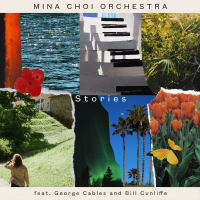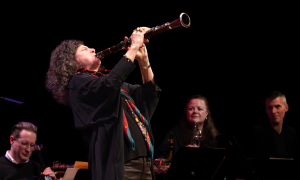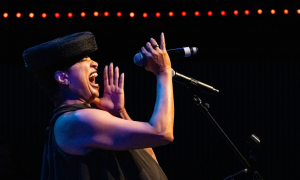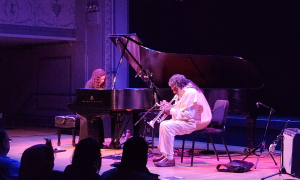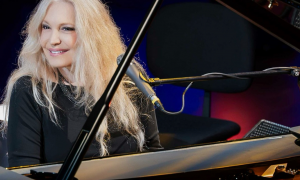Home » Jazz Articles » Live Review » Under the Big Top: Detroit's 31st Year Hits a High Note
Under the Big Top: Detroit's 31st Year Hits a High Note

The mixture of mainstream jazz and other styles was once again handled sagaciously, with a smattering of blues and soul acts thrown in for good measure.
Hart Plaza
Detroit, Michigan
September 3-6, 2010
Last year may have been their 30th anniversary year, but this past Labor Day weekend, The Detroit Jazz Festival pulled out all the stops for what had to be one of the most memorable line-ups of recent memory. Mother Nature would cooperate for the most part, with pleasant temperatures and no precipitation for the majority of the weekend, although a few of the nights got pretty chilly. The mixture of mainstream jazz and other styles was once again handled sagaciously, with a smattering of blues and soul acts thrown in for good measure. There were also some notable 'firsts' making the event something special, including rare appearances from Tower of Power and the Maria Schneider Orchestra.
Setting up camp at Hart Plaza, three main stages held the majority of the major performances, with other smaller venues hosting sets by high school groups, presentations geared for children, and discussions on a range of topics with some of the participating musicians. Just a hop across Jefferson Avenue and down Woodward a few blocks, the lovely Campus Martius would play host to acts with more of a popular appeal, and they ranged from The Mambo Legends Orchestra to New Orleans icon Allen Toussaint. And if you hadn't had your share of music by day's end, each evening the bar at the Marriott hotel would be host to an extended jam session. Over the course of the weekend, this reviewer spotted many of the event's heavyweights enjoying the afterglow, including Matt Wilson, Seamus Blake, Terrence Blanchard, Rodney Green, Jimmy Haslip, Peter Bernstein, Mike LeDonne, and artist-in-residence Mulgrew Miller.
Hitting the road right after work, this reviewer checked into the hotel on opening night and made it over to Campus Martius just in time to catch the last few numbers by the vocal combo Take 6 with Mulgrew Miller and his trio. Although not my particular cup of tea, these gentlemen certainly have talent and their blend of harmonies is quite remarkable, especially when singing a capella. They appeared to set the bar high for what was to come, but once the gauntlet was thrown down, the competition was on.
 Tower of Power would then hit the stage and they were by no means ready to play second fiddle. Lead vocalist Larry Braggs worked the crowd with his high-energy approach and an equally phenomenal voice that brought freshness to all of the bands favorite oldies. Hard to believe these guys have been together for over 40 years. Drummer Dave Garibaldi and bassist Rocco Prestia anchored the groove for a generous set that often brought the packed house to its feet. The iconic "What is Hip?" and "Soul with a Capital 'S'" were standouts, along with an impressive James Brown salute that featured Detroit native Emilio Castillo singing "Diggin' on James Brown."
Tower of Power would then hit the stage and they were by no means ready to play second fiddle. Lead vocalist Larry Braggs worked the crowd with his high-energy approach and an equally phenomenal voice that brought freshness to all of the bands favorite oldies. Hard to believe these guys have been together for over 40 years. Drummer Dave Garibaldi and bassist Rocco Prestia anchored the groove for a generous set that often brought the packed house to its feet. The iconic "What is Hip?" and "Soul with a Capital 'S'" were standouts, along with an impressive James Brown salute that featured Detroit native Emilio Castillo singing "Diggin' on James Brown."Saturday brought with it much cooler temperatures, although the sun poked through occasionally. Detroit drummer and percussionist Maruga Booker would spark some heat at the main amphitheatre with his large ensemble featuring avant-garde clarinetist Perry Robinson and tabla master Badal Roy. Extended jams and a hypnotic groove were the entrée of choice, a culinary feast that certainly would have pleased any Deadhead, not to mention the free jazz iconoclasts in the audience. A complete 360 stylistically, The Michigan State University Jazz Orchestra next took to the stage with special guests Mulgrew Miller and Gary Smulyan. The focus was primarily on bop numbers, but clever arrangements of "Tones for Joan's Bones" and Miller's "Second Thoughts" provided the needed balance.
Meanwhile over at the waterfront stage, saxophonist Tia Fuller was busy gaining some new fans. While one might think that her recent time spent performing with Beyonce might have dulled her jazz chops, nothing but the contrary was on evidence during a perfect set. Fuller has been heard at previous festivals, but this is the best she has sounded. Weighing in with several numbers from her recent disc Decisive Steps (Mack Avenue, 2010), Fuller spoke in a variety of tongues, from the Ornette-like tonal manipulations heard on "Decisive Steps" to the burnished tone of her curved soprano on "Kissed By the Sun." Drummer Rudy Royston and pianist Shamie Royston can share the accolades as integral members of a well-oiled quartet that is solidly hitting its stride.
Moving into the late afternoon and evening, I found myself stage hopping to catch snippets of several acts that had overlapping performance schedules. Pianist Danilo Pérez has been spending the past several years with Wayne Shorter and strains of the saxophonist's ethereal approach can also be heard in Perez's somewhat erratic style. He likes to season his pieces with a good deal of variety and shifts in mood and tempo. Percussionist Roggerio Boccato would add further layers of rhythmic complexity. A special sense of unity would emerge over the Latin groove of "Providencia," with alto man Rudresh Mahanthappa helping to make Perez's fusion seem much more individualistic.
Over at the pyramid stage, Scott Kinsey was turning a few heads with a contemporary mix that seemed somewhat a blast from the past. Shades of Zawinul, Weather Report, and Mahavishnu were the signposts that marked the way down a few new paths to some familiar destinations. The standout element would be the work of Seamus Blake. His EWI solos were electric in both the literal and figurative sense. Patched into foot pedals and a Mac computer, Blake even strapped on a headset to trigger the horn through a vocoder. Far from a one-trick pony, Blake was equally inspired when picking up his tenor sax.
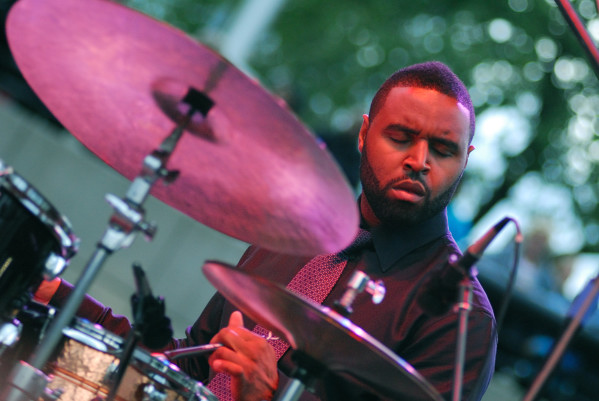
Back to the amphitheatre, Terence Blanchard and his quintet were full long into a rich set filled with the trumpeter's passionate playing and synergy with his quintet that makes this one of the music's finest working ensembles. Drummer Kendrick Scott maybe a new name to some, but he has been quickly climbing the ladder to the upper echelon of modern day jazz masters. His melodic approach is perfectly attuned to Blanchard's equally rhapsodic style. Pianist Fabian Almazan also proved to be a talent worth of wider recognition and my only regret was that my time was short, as I planned on closing out the evening at the pyramid stage for a double dose of greasy organ combos.
 Having performed and recorded with a number of top-shelf players including Tim Warfield, Lou Donaldson, and Mark Whitfield, up-and-coming Rochester native Pat Bianchi would make his debut in Detroit with a satisfying set that found the Hammond B3 organist worthy of the praise from such mentors as Joey DeFrancesco. Like fellow forward thinkers Gary Versace and Sam Yahel, Bianchi is more interested in pushing the envelope in the direction of Larry Young than revisiting the grits and gravy approach of Jimmy Smith or Jack McDuff. His own originals and choice of standards such as Wayne Shorter's "Black Nile" and Herbie Hancock's "Tell Me a Bedtime Story" bore out his modus operandi. Guitarist Steve Kovalcheck provided a fine counterpoint with a tasty mix of single note lines and chock-a-block chords.
Having performed and recorded with a number of top-shelf players including Tim Warfield, Lou Donaldson, and Mark Whitfield, up-and-coming Rochester native Pat Bianchi would make his debut in Detroit with a satisfying set that found the Hammond B3 organist worthy of the praise from such mentors as Joey DeFrancesco. Like fellow forward thinkers Gary Versace and Sam Yahel, Bianchi is more interested in pushing the envelope in the direction of Larry Young than revisiting the grits and gravy approach of Jimmy Smith or Jack McDuff. His own originals and choice of standards such as Wayne Shorter's "Black Nile" and Herbie Hancock's "Tell Me a Bedtime Story" bore out his modus operandi. Guitarist Steve Kovalcheck provided a fine counterpoint with a tasty mix of single note lines and chock-a-block chords.Closing out the evening, it was Mike LeDonne's quartet who really fanned the flames on a brisk and nippy evening. We're talking primo A-list New Yorkers for this unit, one that festival director Terri Pontremoli told me she had just recently heard in Manhattan at the club Smoke, where they have been holding fort for some time now. While many may be familiar with LeDonne as one of jazz music's best pianists and accompanists, he's also been building a reputation as a tasty B3 practitioner through a fine series of discs for the Savant label. Tenor man Eric Alexander, guitarist Peter Bernstein, and drummer Joe Farnsworth share a history together and countless gigs that helps foster a creative vibe that everyone thrives on. LeDonne has a special knack for updating soul classics from the '70s, adding a shuffle beat to Michael Jackson's "Rock With You" and the Temptation's "I'm Going to Make You Love Me." Without a degree of hyperbole, the fireworks soared during LeDonne's closing set prior to the pyrotechnics that filled the skies with sizzling colors and crackling sounds in what has become a Saturday night tradition at the fest.
The buzz at Sunday afternoon brunch was all about Maria Schneider and her debut at the festival, a rare appearance outside of her New York environs. She certainly didn't disappoint with a generous set that was one of the highlights of the entire festival. A thoroughly unique composer and catalyst for inspiration, Schneider's ensemble included a top-notch array of New York's finest with drummer Kendrick Scott again providing to be a valuable foil. Trumpeter Greg Gisbert along with saxophonists Rich Perry, Donny McCaslin, and Steve Nelson would all be featured on various numbers, Gisbert being honored with a feature on an encore of "My Ideal." Written with the memories of a Texas diner as fodder, "Tork's Café" was almost an aural travelogue with its rich harmonies and shifting moods. "El Viento" spoke in a lilting bossa beat, while "Hang Gliding" took a programmatic stance. Fortunately the audience response was on par with Schneider's own obvious enthusiasm. It was a tough act to follow indeed.

Becoming the norm during recent festivals, several matches were made uniting one of the national artists with a few of the Michigan area's finest college ensembles. A smart choice was made when Terrence Blanchard joined forces with the Wayne State University Big Band. Instead of retreads of the standard big band repertoire, Blanchard's experience with writing movie soundtracks served as a creative element. Themes and music from some of the iconic soundtracks of the '50s and '60s were revisited with Blanchard at the top of his game. Standout arrangements included themes from "The Pawnbroker," "Chinatown," and "Anatomy of a Murder."
A complete contrast to the large ensemble performances that kicked off the afternoon, Trio M prepared to engage in spontaneous improvisation of the variety that has been highly touted by devotees of the free jazz crowd. Pianist Myra Melford, bassist Mark Dresser, and drummer Matt Wilson virtually define the word 'contemporary' and they didn't fail to engage the crowd with a presentation that was as much fun to listen to as to watch. At times, Melford would reach inside the piano to pluck a string or two. She struck me as a savory cross between Cecil Taylor and Don Pullen. Dresser picked, bowed, and tapped his bass to call on different sounds and textures. Wilson is always listening and complimentary and he has his own set of techniques, including muffling his drums with rags and cymbals and utilizing various auxiliary percussion.
 Back to the amphitheatre to close out the night, an ensemble of veterans was gathering under the banner of Defenders of the Groove. The front line would include Eddie Henderson, Bobby Watson, and Steve Turre. Other key players would be guitarist Melvin Sparks and drummer Louis Hayes. The material was certainly familiar and seemed to be a crowd pleaser, with vocalist Ernie Andrews weighing in on "Danger Zone" and "Goin' to Kansas City." Turre picked up the conch shells for an appropriately titled "Funky Knuckles" and Sparks was featured on "Alligator Boogaloo." Nothing all that memorable occurred, but a goodtime was had by most.
Back to the amphitheatre to close out the night, an ensemble of veterans was gathering under the banner of Defenders of the Groove. The front line would include Eddie Henderson, Bobby Watson, and Steve Turre. Other key players would be guitarist Melvin Sparks and drummer Louis Hayes. The material was certainly familiar and seemed to be a crowd pleaser, with vocalist Ernie Andrews weighing in on "Danger Zone" and "Goin' to Kansas City." Turre picked up the conch shells for an appropriately titled "Funky Knuckles" and Sparks was featured on "Alligator Boogaloo." Nothing all that memorable occurred, but a goodtime was had by most.Making me realize how much I have missed his presence on discs and in person, pianist Benny Green was such a pleasure to hear as he joined forces with bassist Christian McBride and drummer Karriem Riggins in a tribute to Ray Brown to conclude Sunday night's festivities. Both Green and McBride were lucky enough to count the late great bassist as a mentor and employer. What made the homage transcend mere gimmick is that fact that both men have built on the tradition as a way to find their own unique voices. The range of moods was disparate, from the meditative Lil' Darlin'" to the second line groove of "Gumbo Hump." Riggins upped the ante and made the difference for a set that might have been far less engaging had the drummer been less accomplished.
The pace continued to be spirited as we headed into Labor Day. There was still plenty of heady stuff to be heard. Roy Haynes and his Fountain of Youth band were the first main act to be heard at the amphitheatre. Now certainly the fact the Haynes continues to be as strong a drummer as he ever was is something to marvel. What is a bit confounding is the fact that the gentlemen he keeps company work are talented, but not in a way that adds anything new to Haynes's music. In fact, I had seen the same band a few years back and the set list in Detroit was almost identical. Taking nothing away from what was still a fine performance, perhaps the drummer might benefit from a change in scenery.
After an absence of several years, saxophonist Branford Marsalis returned to Detroit with a slightly altered band. After joining Marsalis, pianist Joey Calderazzo, and bassist Eric Revis for a lengthy and impressive run, drummer Jeff Tain Watts recently left the fold opening the door for the next new drum phenom. Justin Faulkner has found his niche with this band and Marsalis seemed to be inspired by this new unit. One of the main practitioners of what has been called "the burn," Marsalis and his cohorts packed quite a punch with such numbers as "Teo" and "Return of the Jitney Man." With shades of Coltrane's "A Love Supreme," a rhapsodic "Hope" featured Calderazzo at length on a stunning solo.

Hard bop was the flavor of the day for the last two sets I would take in before hitting the road back to Cleveland. Back in the late '80s, alto man Bobby Watson co-led the group Horizon with drummer Victor Lewis. This group carried the flag for a new mainstream style that built upon the traditions of Art Blakey and Miles Davis. Their reunion in Detroit was something to celebrate and from the first note it was as if time had never really passed. A familiar sense of timelessness marks the music of Horace Silver and pianist Michael Weiss capitalized on this for a tribute to Silver. Trumpeter Randy Brecker, a Silver alumnus, would lead the front line with tenor man Wayne Escoffery as the ensemble would revisit such early numbers as "Enchantment," "Where You At?" and "Nica's Dream." One bone of contention would be that too little attention was paid to Silver's later work such as "Nutville" or "Mexican Hip Dance." Nonetheless, an obligatory encore of "Song for My Father" pleased an appreciative crowd.
View more 2010 Detroit Jazz Festival photo here.
Photo credit:
C. Andrew Hovan
Tags
Detroit International Jazz Festival
Live Reviews
C. Andrew Hovan
United States
Mulgrew Miller
Tower of Power
Gary Smulyan
Tia Fuller
Rudy Royston
Danilo Perez
Wayne Shorter
Rudresh Mahanthappa
The Scott Kinsey Group
Seamus Blake
Terence Blanchard
Kendrick Scott
Fabian Almazan
Pat Bianchi
Joey DeFrancesco
Gary Versace
Sam Yahel
Larry Young
Jimmy Smith
Jack McDuff
Mike LeDonne
Eric Alexander
Peter Bernstein
Joe Farnsworth
Greg Gisbert
Rich Perry
Donny McCaslin
Trio M
Myra Melford
Mark Dresser
Matt Wilson
Eddie Henderson
Bobby Watson
Steve Turre
Melvin Sparks
Louis Hayes
Ernie Andrews
Benny Green
Christian McBride
Karriem Riggins
Roy Haynes
Branford Marsalis
Joey Calderazzo
Eric Revis
Jeff "Tain" Watts
Justin Faulkner
Victor Lewis
Michael Weiss
randy brecker
Wayne Escoffery
PREVIOUS / NEXT
Support All About Jazz
 All About Jazz has been a pillar of jazz since 1995, championing it as an art form and, more importantly, supporting the musicians who make it. Our enduring commitment has made "AAJ" one of the most culturally important websites of its kind, read by hundreds of thousands of fans, musicians and industry figures every month.
All About Jazz has been a pillar of jazz since 1995, championing it as an art form and, more importantly, supporting the musicians who make it. Our enduring commitment has made "AAJ" one of the most culturally important websites of its kind, read by hundreds of thousands of fans, musicians and industry figures every month.












